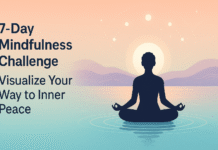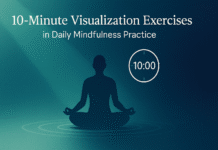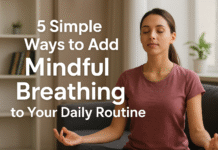Mindfulness meditation is a simple, portable practice that trains you to pay attention—on purpose, in the present moment, and without judgment. In the next several thousand words you’ll learn the seven major, evidence-backed benefits of mindfulness meditation, step-by-step beginner instructions for each benefit, safety notes, troubleshooting tips, a practical 4-week starter plan, and a bank of FAQs to keep you moving forward. This article is written for busy adults, stressed professionals, caregivers, students, and anyone who wants clear, practical ways to improve mental and physical well-being through an accessible daily habit.
Medical disclaimer: this article provides educational information only. For personalized medical or mental-health advice—especially if you have a diagnosed condition, are pregnant, or experience severe emotional distress—consult a qualified health professional before beginning any new wellbeing practice.
Key takeaways
- Mindfulness meditation supports seven practical gains: reduced stress and anxiety, better focus, emotional resilience, improved sleep, reduced pain, deeper self-awareness, and greater compassion.
- No special equipment required: you can start in minutes with an inexpensive timer and a quiet corner.
- Actionable guidance: each benefit below includes clear beginner steps, low-cost alternatives, safety caveats, and a tiny sample mini-plan you can try today.
- Measure progress: brief daily logs and weekly self-ratings are enough to see real change over weeks.
- Sustainable roadmap: a 4-week starter plan helps you build habit and scale your practice sensibly.
1. Reduced stress and anxiety
What it is and core benefits
Mindfulness meditation trains your attention so you can notice patterns of worry and stress as they arise without being swept away by them. Practiced regularly, it can reduce perceived stress, lower anxiety symptoms, and improve overall psychological well-being. Large reviews of meditation programs report small to moderate reductions in multiple dimensions of psychological stress following structured mindfulness training.
Requirements / low-cost alternatives
- Requirements: A quiet chair or cushion, a timer (phone or kitchen timer), and 5–20 minutes of uninterrupted time.
- Low-cost alternatives: Practice sitting in your car before leaving for work, or do a 3-minute standing breath check while waiting for water to boil.
Step-by-step beginner instructions
- Settle into a comfortable seated position with feet grounded and hands resting on your lap.
- Set a timer for 5 minutes to start (no need to clock-watch).
- Bring attention to the breath. Notice inhalation and exhalation at the tip of the nose or the rise and fall of the chest.
- When thoughts or worries arise, silently label them “thinking” or “worry,” then gently return your attention to the breath.
- End by opening your eyes and taking two deliberate breaths before standing.
Beginner modifications and progressions
- Simplify: If 5 minutes feels long, begin with 2 minutes of breath awareness and gradually add 30–60 seconds each week.
- Progress: After establishing basic breath practice, introduce a short body-scan (5–10 minutes) to expand interoceptive awareness.
Recommended frequency, duration, and metrics
- Beginner: 5 minutes daily, 5–7 days a week.
- Progression: Work toward 10–20 minutes per day across several weeks.
- Metric: Track sessions per week and use a simple pre/post self-rating of perceived stress (0–10) once per day or week.
Safety, caveats, common mistakes
- Caveat: For some people with trauma or severe anxiety, sitting quietly can temporarily increase distress. If this happens, shorten sessions, practice with a trained instructor, or use an active grounding practice first.
- Common mistake: Expecting the mind to be blank. The goal is awareness of wandering, not a thoughtless state.
Sample mini-plan (2–3 steps)
- Sit for 3 minutes focusing on breath.
- When worry appears, note “worry,” return to breath.
- Finish by jotting one sentence on how you feel.
2. Improved focus and concentration
What it is and core benefits
Mindfulness strengthens the mental skill of sustained attention and the ability to re-orient attention after distraction. Short training programs and randomized studies have demonstrated improvements in attention and certain cognitive functions after mindfulness practice, including the capacity to sustain attention during demanding tasks. These benefits can appear after brief, consistent training.
Requirements / low-cost alternatives
- Requirements: Same minimal setup—chair, timer, quiet.
- Low-cost alternative: Use a single visible object (a pebble, candle flame) as a focal point if breath focus is challenging.
Step-by-step beginner instructions
- Choose a focus (breath or a small object).
- Set a timer for 5–10 minutes.
- Direct attention to the chosen focus and notice details (texture, rhythm, temperature).
- When the mind wanders, note “wandering” or “thinking” and gently bring attention back.
- Finish by noting one moment of focus during the session.
Beginner modifications and progressions
- Simplify: Start with 2–3 minute focused sessions and increase duration by 1–2 minutes weekly.
- Progress: Practice “distraction training”—deliberately introduce mild background noise and practice returning attention.
Recommended frequency, duration, and metrics
- Beginner: 5 minutes daily or 5 times weekly.
- Progression: Build toward 20 minutes daily for stronger, broader cognitive benefits.
- Metric: Use a weekly productivity or focus score (e.g., number of distraction-free work intervals completed).
Safety, caveats, common mistakes
- Safety: Do not practice while driving or operating heavy machinery.
- Common mistakes: Forcing attention; expecting immediate gains. The skill builds gradually.
Sample mini-plan
- 5 minutes breath focus before starting work.
- Use a 25-minute work block (Pomodoro) and observe whether you manage fewer distractions.
3. Greater emotional resilience and regulation
What it is and core benefits
Emotional resilience here means the ability to experience difficult emotions without being overwhelmed by them and to recover more quickly. Mindfulness practice cultivates an attitude of curious observation toward emotions, which reduces reactivity and supports more deliberate responses. Research shows mindfulness-based programs can reduce symptoms of anxiety and depression and help participants respond to emotional challenges with less automatic reactivity.
Requirements / low-cost alternatives
- Requirements: A quiet space and willingness to bring gentle curiosity to emotions.
- Low-cost alternative: A short mindful pause (3 deep breaths) when you notice agitation during the day.
Step-by-step beginner instructions
- Sit or stand comfortably and take two grounding breaths.
- Bring to mind a recent emotion (frustration, sadness, anxiety).
- Name it silently (“anger,” “sadness”) and feel where it shows up in the body.
- Breathe into that area, noticing sensations without pushing them away.
- Conclude by asking: “What do I need now?”—then choose one small, kind response.
Beginner modifications and progressions
- Simplify: Use a 1-minute breathing space (notice, label, breathe).
- Progress: Add journaling after the practice to explore triggers and patterns.
Recommended frequency, duration, and metrics
- Beginner: Short micro-practices (1–3 minutes) during emotionally charged moments; 5–10 minutes daily for skill building.
- Metric: Track frequency of emotional flare-ups and time to recovery (how long you stay upset).
Safety, caveats, common mistakes
- Caveat: If observing emotions triggers overwhelming responses or flashbacks, stop and seek a trauma-informed therapist’s guidance.
- Common mistake: Using mindfulness to suppress emotion; instead, allow and observe nonjudgmentally.
Sample mini-plan
- Take three deliberate breaths when noticing tension.
- Name the feeling.
- Breathe into the physical sensation for 60 seconds.
4. Better sleep quality
What it is and core benefits
Mindfulness practices—especially mindful body-scan and breath awareness—help quiet racing thoughts that disrupt sleep. Clinical trials and systematic reviews report that mindfulness interventions yield small to moderate improvements in sleep quality and may be helpful for insomnia symptoms. Practicing mindfulness before bedtime can shorten time to fall asleep and improve perceived restfulness.
Requirements / low-cost alternatives
- Requirements: A comfortable place to lie down or recline, dim lighting, and a 10–20 minute window before bed.
- Low-cost alternative: A shorter 3–5 minute breath awareness or a guided body-scan recording.
Step-by-step beginner instructions
- Lie down in a comfortable position.
- Set a soft timer for 10–15 minutes.
- Perform a gentle body-scan from toes to head, noticing tension and inviting soft release.
- Shift attention to slow diaphragmatic breathing if your mind races.
- If you fall asleep during the scan, that’s fine—allow it.
Beginner modifications and progressions
- Simplify: Start with 5 minutes of breath awareness before lights-out.
- Progress: Build to a 20-minute evening body-scan or add a short gratitude reflection to close the day.
Recommended frequency, duration, and metrics
- Beginner: 5 minutes nightly; increase to 10–20 minutes over several weeks.
- Metric: Track sleep onset latency, number of awakenings, and morning restfulness using a simple log.
Safety, caveats, common mistakes
- Caveat: If lying flat triggers nightmares or dissociation, sit upright and do breathing practice instead.
- Common mistake: Checking the clock—turn clocks away or use a non-illuminated timer.
Sample mini-plan
- 5 minutes breath awareness while lying in bed.
- 5 minutes body-scan focusing on softening the jaw and shoulders.
5. Reduced physical pain and better pain management
What it is and core benefits
Mindfulness teaches a different relationship to sensation: noticing pain without amplifying secondary suffering such as fear, judgment, or resistance. Systematic reviews find small but meaningful reductions in pain intensity and improvements in quality of life for people with chronic pain after mindfulness training. Mindfulness is typically complementary to medical treatments rather than a replacement.
Requirements / low-cost alternatives
- Requirements: A posture that accommodates current comfort (sitting in a supportive chair or lying on a bed).
- Low-cost alternative: Use brief 2–3 minute mindful check-ins during pain flare-ups.
Step-by-step beginner instructions
- Find a supported position where you can remain reasonably still without increasing pain.
- Begin with 2 minutes of breath awareness to anchor attention.
- Bring attention to the painful area, noticing qualities (intensity, location, temperature).
- Observe any urge to push away or narrate (“This is unbearable”) and gently note “pushing” or “story,” then return to the sensation itself.
- Close with a few breaths and a brief grounding phrase (“I am here”).
Beginner modifications and progressions
- Simplify: If focusing on pain is too intense, begin with body-scans that avoid the most painful region at first.
- Progress: Add longer sessions (10–20 minutes) and integrate mindfulness into physical therapy or gentle movement.
Recommended frequency, duration, and metrics
- Beginner: 2–5 minutes during flare-ups; 10–15 minutes daily for ongoing management.
- Metric: Record pain intensity (0–10) before and after sessions, and monitor functional outcomes (e.g., time spent walking, sleep quality).
Safety, caveats, common mistakes
- Safety: Mindfulness is not a substitute for medical diagnosis or urgent care. If pain worsens acutely or is unexplained, seek medical attention.
- Common mistake: Expecting immediate elimination of pain rather than a changed relationship to it.
Sample mini-plan
- Anchor with 2 minutes of paced breathing.
- Spend 3 minutes observing sensations without judgment.
- Record pain score and note any change.
6. Enhanced self-awareness and insight
What it is and core benefits
Mindfulness cultivates noticing—of thoughts, habitual patterns, and impulse triggers. That increased self-awareness supports better decision making and behavior change because you can catch automatic responses before you act. Reviews of mindfulness interventions highlight improvements in psychological flexibility and self-reported insight, which can help with habits, relationships, and goal pursuit.
Requirements / low-cost alternatives
- Requirements: A notebook (optional) for brief reflections after practice.
- Low-cost alternative: Use voice memos to record a single insight after a session if you prefer speaking to writing.
Step-by-step beginner instructions
- Practice a 5-minute breath meditation.
- Notice recurring thoughts or judgments (e.g., “I should be further along”).
- Label patterns (e.g., “self-criticism”) and return to breath.
- After the session, write one line describing the pattern and one small experiment to test a new response this week.
Beginner modifications and progressions
- Simplify: Use a 2-minute “awareness check” once daily (notice one thought pattern).
- Progress: Integrate mindfulness into behavior experiments—observe a trigger and choose a different response.
Recommended frequency, duration, and metrics
- Beginner: 5 minutes, three times per week; progress to daily 10–15 minute sessions.
- Metric: Count the number of times you catch a habitual response before acting (weekly).
Safety, caveats, common mistakes
- Caveat: Intense self-analysis can sometimes lead to rumination. If reflection becomes repetitive and distressing, shift to a more grounding, body-based practice.
- Common mistake: Confusing insight with immediate change—awareness is the first step, action follows.
Sample mini-plan
- Five-minute breath practice.
- Note one recurring thought.
- Plan one small experiment (e.g., pause for one breath before replying in a difficult conversation).
7. Greater compassion, empathy, and social connection
What it is and core benefits
Certain mindfulness practices—especially loving-kindness or compassion meditations—explicitly cultivate feelings of goodwill toward yourself and others. Emerging research suggests these practices can increase empathy and prosocial behavior in some contexts, though results vary and effects can depend on how compassion training is taught and participants’ cultural backgrounds. Mindfulness that includes compassion practices often supports better relationships, greater patience, and a more generous orientation toward others.
Requirements / low-cost alternatives
- Requirements: Seated time and simple phrases to repeat silently (e.g., “May I be well. May you be safe.”).
- Low-cost alternative: During daily routines (washing dishes, walking), silently extend a wish of well-being to someone you know.
Step-by-step beginner instructions (loving-kindness)
- Sit comfortably and breathe for two minutes to center.
- Bring to mind someone who easily elicits warm feelings (a friend or pet).
- Silently repeat short phrases: “May you be happy. May you be safe. May you be free from suffering.”
- After several repetitions, extend the phrases to yourself, then to a neutral person, and finally to a difficult person.
- Finish by resting in the sensation of goodwill for a minute.
Beginner modifications and progressions
- Simplify: Start by practicing compassion toward yourself only.
- Progress: Extend the duration and include guided compassion practices or formal compassion-training programs.
Recommended frequency, duration, and metrics
- Beginner: 3–5 minutes, 3 times per week.
- Progression: 10–20 minutes daily for deeper interpersonal effects.
- Metric: Self-report of empathy, frequency of helping behaviors, or relationship satisfaction ratings over time.
Safety, caveats, common mistakes
- Caveat: For some, focusing on compassion toward others—especially those who have harmed you—can provoke distress. If that happens, return to self-compassion first.
- Common mistake: Repeating phrases mechanically without engaging feeling—allow warmth to arise gradually.
Sample mini-plan
- Two minutes breath awareness.
- Three minutes loving-kindness toward yourself.
- One minute extending warmth to someone else.
Quick-start checklist and warm-up
- Find a consistent time and place (even 2 minutes counts).
- Wear comfortable clothes and silence notifications.
- Set a simple timer (no alarms with harsh tones).
- Warm-up: take three long, audible exhales to release tension.
- Start with a basic breath practice or a guided 5-minute recording.
Troubleshooting and common pitfalls
- “My mind never stops.” That’s the central experience of practice—notice thought, label it, and return. The repeated return builds attention.
- “I fall asleep.” Try sitting rather than lying, practice earlier in the evening, or shorten sessions. Sleep during practice can also indicate bodily need.
- “It makes me feel worse.” Rarely, mindfulness brings up difficult material. If you feel overwhelmed, shorten sessions, practice grounding exercises, or connect with a professional.
- “I don’t have time.” Micro-practices (30–60 seconds) can be remarkably effective—pair them with routine habits like brushing teeth.
- “I’m not sure I’m doing it right.” The simplest gauge is consistency; if you practice regularly and notice small shifts over weeks, you’re on track.
How to measure progress
- Session log: Record date, duration, type of practice, and one word describing how you felt afterward.
- Weekly ratings: Rate stress, focus, sleep quality, or pain on a 0–10 scale once per week.
- Behavioral KPIs: Track the number of distraction-free work blocks, days without reacting angrily, or minutes walked.
- Reflective checkpoints: At the end of each week, write one concrete example of something you handled differently because you noticed your reaction.
A simple 4-week starter plan
Goal: Build a sustainable habit and sample practices that map to the seven benefits.
Week 1 — Building the habit (5 minutes daily)
- Days 1–7: 5 minutes of breath awareness each morning after getting out of bed.
- Focus: reduce stress and begin training attention.
Week 2 — Expand variety (5–8 minutes daily)
- Alternate days: breath focus (M/W/F), body-scan (T/Th), and a 3-minute loving-kindness practice (Sat).
- Focus: attention + gentle body awareness.
Week 3 — Deepen emotional skills (10 minutes daily)
- 3 days: 10 minutes body-scan or emotion-focused mindfulness.
- 2 days: 10 minutes loving-kindness.
- 2 days: 10 minutes focused attention for concentration.
Week 4 — Integrate and personalize (10–20 minutes daily)
- Build a sequence: 5 minutes breath → 10 minutes body-scan → 5 minutes loving-kindness on alternate days.
- Add evening 5-minute breath practice on two nights to improve sleep.
Weekly checkpoints
- At the end of each week, note session frequency and rate stress, sleep, and focus (0–10). Adjust durations to protect consistency.
Frequently asked questions (8–12)
- How long before I notice benefits?
Many people notice small changes—like a little more calm—after the first session. More reliable, persistent benefits usually begin to appear after 2–8 weeks of regular practice. - Do I need an app or teacher?
Apps and teachers can accelerate learning and accountability, but you can also start effectively on your own with short, consistent sessions. - What if I have a mental-health diagnosis?
Mindfulness can be helpful, but consult your mental-health provider. Some forms of meditation can temporarily increase distress—use trauma-informed guidance if needed. - Can children and teens practice mindfulness?
Yes—short, playful practices tailored to age work well. Keep sessions brief and integrate movement for younger children. - Is mindfulness religious?
Mindfulness has roots in contemplative traditions but can be taught secularly as a mental-health and performance tool. - What’s the difference between mindfulness and relaxation?
Relaxation aims to reduce tension; mindfulness emphasizes present-moment awareness, which may or may not be relaxing but leads to clearer insight and better self-regulation. - Can mindfulness replace medical treatment?
No. Mindfulness is a complementary tool. For medical conditions, use it alongside professional care. - Why practice compassion meditations?
Compassion practices intentionally cultivate warmth toward self and others, supporting better relationships and reducing harsh self-judgment. - How do I handle boredom?
Shorten sessions, try a different format (movement, body-scan, loving-kindness), or anchor practice to a routine activity. - Is there a “best” time to practice?
No universal best time—choose a consistent time that fits your life. Morning practice can set tone; evening practice helps wind down. - How can I keep practicing when traveling?
Do 2–5 minute seat-based practices in airports, or use guided recordings when you have brief pockets of time. - What should I expect after a year of practice?
Many long-term practitioners report more stable attention, quicker emotional recovery, improved sleep, and more intentional relationships—but individual outcomes vary.
Conclusion
Mindfulness meditation offers practical, accessible ways to reduce stress, sharpen concentration, regulate emotions, sleep better, manage pain, deepen self-awareness, and increase compassion. The practice is simple but not always easy; it rewards consistency, kindness toward yourself, and small, steady investments of time. Use the starter plan, quick mini-practices, and the measurement ideas above to build a habit that fits your life. Remember: the goal isn’t perfection—it’s repeated, curious attention to your moment-to-moment experience.
Call to action: Take two minutes right now: breathe in slowly, breathe out slowly, and begin.
References
- Meditation programs for psychological stress and well-being — PubMed (JAMA Internal Medicine systematic review), 2014. PubMed
- Mindfulness meditation improves cognition: evidence of brief mental training — PubMed, 2010. PubMed
- The effect of mindfulness meditation on sleep quality: a systematic review and meta-analysis — PubMed, 2019. PubMed
- Mindfulness Meditation for Chronic Pain: Systematic Review and Meta-Analysis — PubMed Central (PMC), 2017. PMC
- Mindfulness and related interventions: A systematic review and meta-analysis of effects on mental health and well-being — PMC article, 2021. PMC
- The effect of mindfulness-based programs on cognitive function in adults: a systematic review and meta-analysis — PMC article, 2022. PMC
- Mindfulness Meditation and Improvement in Sleep Quality and Daytime Impairment Among Older Adults With Sleep Disturbances: A Randomized Clinical Trial — JAMA Internal Medicine, 2015. JAMA Network
- Mindfulness may be associated with less prosocial engagement in some contexts; research on compassion and prosociality — Systematic reviews and recent studies (examples): PMC review and recent experimental studies, 2018–2023. and and PMCSpringerLinkNature
- Mindfulness-based interventions for pain: RAND systematic review — RAND Corporation research report, 2017. RAND Corporation




































